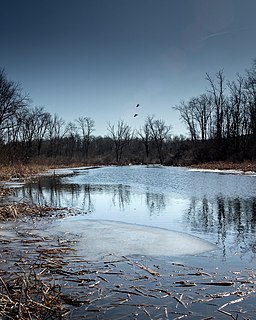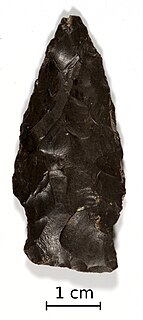A shotgun is a long-barreled firearm designed to shoot a straight-walled cartridge known as a shotshell, which usually discharges numerous small pellet-like spherical sub-projectiles called shot, or sometimes a single solid projectile called a slug. Shotguns are most commonly smoothbore firearms, meaning that their gun barrels have no rifling on the inner wall, but rifled barrels for shooting slugs are also available.

In North American archaeological terminology, a projectile point is an object that was hafted to a weapon that was capable of being thrown or projected, such as a javelin, dart, or arrow. They are thus different from weapons presumed to have been kept in the hand, such as knives, spears, axes, hammers, and maces.

Clovis points are the characteristically fluted projectile points associated with the New World Clovis culture, a prehistoric Paleo-American culture. They are present in dense concentrations across much of North America and they are largely restricted to the north of South America. Clovis points date to the Early Paleoindian period, with all known points dating from roughly 13,500 to 12,800 years ago. Clovis fluted points are named after the city of Clovis, New Mexico, where examples were first found in 1929 by Ridgely Whiteman.

The Parrott rifle was a type of muzzle-loading rifled artillery weapon used extensively in the American Civil War.

Balls are projectile points]] associated with the Folsom tradition of North America. The style of tool-making was named after the Folsom Site located in Folsom, New Mexico, where the first sample was found by George McJunkin within the bone structure of a bison, an animal hunted by the Folsom people in New Mexico, in 1908. The Folsom point was identified as a unique style of projectile point in 1926.

Field artillery in the American Civil War refers to the artillery weapons, equipment, and practices used by the Artillery branch to support the infantry and cavalry forces in the field. It does not include siege artillery, use of artillery in fixed fortifications, or coastal or naval artillery. Nor does it include smaller, specialized artillery classified as small arms.
Oshara Tradition, the northern tradition of the Picosa culture, was a Southwestern Archaic Tradition centered in the area now called New Mexico and Colorado. Cynthia Irwin-Williams developed the sequence of Archaic culture for Oshara during her work in the Arroyo Cuervo area of northwestern New Mexico. Irwin contends that the Ancestral Puebloans developed, at least in part, from the Oshara.
McWhinney or McWhinney Heavy Stemmed is a term for a shape of point in prehistoric lithic weapons and tools found primarily in the midwestern United States, dating from the Late Archaic period in the Americas. The McWhinney Heavy Stemmed type has become in some ways a representation of the ambiguous in the field of archaeology. The first to describe the McWhinney point type was J.M. Heilman, based on a surface collection from the McWhinney Village in Preble County, Ohio. Kent Vickery (1972:3) has suggested that McWhinney Heavy Stemmed points, “exhibit considerable stylistic variation, and probably represent several varieties.” The points have been found in Indiana, Ohio, and Kentucky.

Tobyhanna State Park is a Pennsylvania state park on 5,440 acres (2,201 ha) mostly in Coolbaugh Township, Monroe County, with a small portion of the park in Dreher and Lehigh townships in Wayne County, all in Pennsylvania in the United States. The park includes the 170-acre (69 ha) Tobyhanna Lake and a portion of Tobyhanna Creek. It is located 2.1 miles (3.4 km) north of the town of Tobyhanna, with the main park entrance on Pennsylvania Route 423, and a portion that borders on Pennsylvania Route 196. The park lies immediately adjacent to Gouldsboro State Park, Pennsylvania State Game Lands 312, and State Game Land 127.
Lamoka Lake, previously known as Mud Lake, is a small crescent-shaped lake in the western part of New York state. The lake is located at the border of Schuyler County and Steuben County. Most of the lake is in Schuyler County with only a small part, called "Mill Pond," at the southwest corner in Steuben County.

The Lindenmeier Site is a stratified multi-component archaeological site most famous for its Folsom component. The former Lindenmeier Ranch is in the Soapstone Prairie Natural Area, in northeastern Larimer County, Colorado, United States. The site contains the most extensive Folsom culture campsite yet found with a radiocarbon date of 10,600 to 10,720 B.P. Artifacts were also found from subsequent Archaic and Late pre-historic periods.

The Lamoka Site, or simply Lamoka, is an archaeological site near Tyrone, in Schuyler County, New York that was named a National Historic Landmark in 1961. According to the National Park Service, "This site provided the first clear evidence of an Archaic hunting and gathering culture in the Northeastern United States ".

The Paisley Caves or the Paisley Five Mile Point Caves complex is a system of four caves in an arid, desolate region of south-central Oregon, United States north of the present-day city of Paisley, Oregon. The caves are located in the Summer Lake basin at 4,520 feet (1,380 m) elevation and face west, carved into a ridge of Miocene and Pliocene era basalts mixed with soft volcanic tuffs and breccias by Pleistocene-era waves from Summer Lake. One of the caves may contain archaeological evidence of the oldest definitively-dated human presence in North America. The site was first studied by Luther Cressman in the 1930s.

Levanna projectile points are stone projectile points manufactured by Native Americans what is now the Northeastern United States, generally in the time interval of 700-1350 AD. They are true arrowheads rather than atlatl dart points, and they derive their name from the specimens found at the Levanna site in Cayuga County, New York.

Jacks Reef Pentagonal is the name for small, broad projectiles and specialized knives. They were named by William A. Ritchie based on examples recovered from the Point Peninsula Jack's Reef archaeological site in Onondaga County, New York. The projectiles have mostly been dated to within a few hundred years of 900 AD, in the early era of the Owasco culture.
Susquehanna broad projectile points are stone projectile points manufactured by Native Americans what is now the Northeastern United States, generally in the time interval of 1200–700 BC. They are probably atlatl dart points, but some are large enough to have been spear points. They derive their name from the specimens throughout the Susquehanna River Valley in the northeastern United States, particularly Pennsylvania and New York.

The Bare Island projectile point is a stone projectile point of prehistoric indigenous peoples of North America. It was named by Fred Kinsey in 1959 for examples recovered at the Kent-Halley site on Bare Island in Pennsylvania.
Greene projectile points are stone projectile points manufactured by Native Americans what is now the Northeastern United States generally in the time interval of 300–800 AD.

The Paiján culture was an archaeological culture that emerged on the northern coast of Peru between 13,000 and 10,000 cal BP. It was first described by Peruvian archaeologist Rafael Larco Hoyle in the 1940s from the Pampa de los Fósiles site. Later research, mainly by French archaeologist Claude Chauchat, identified dozens of open air sites, which include camps, workshops and quarries.

Hogup Cave is a two-chambered limestone cavern, and an important, well-studied prehistoric Great Basin site in Utah.














